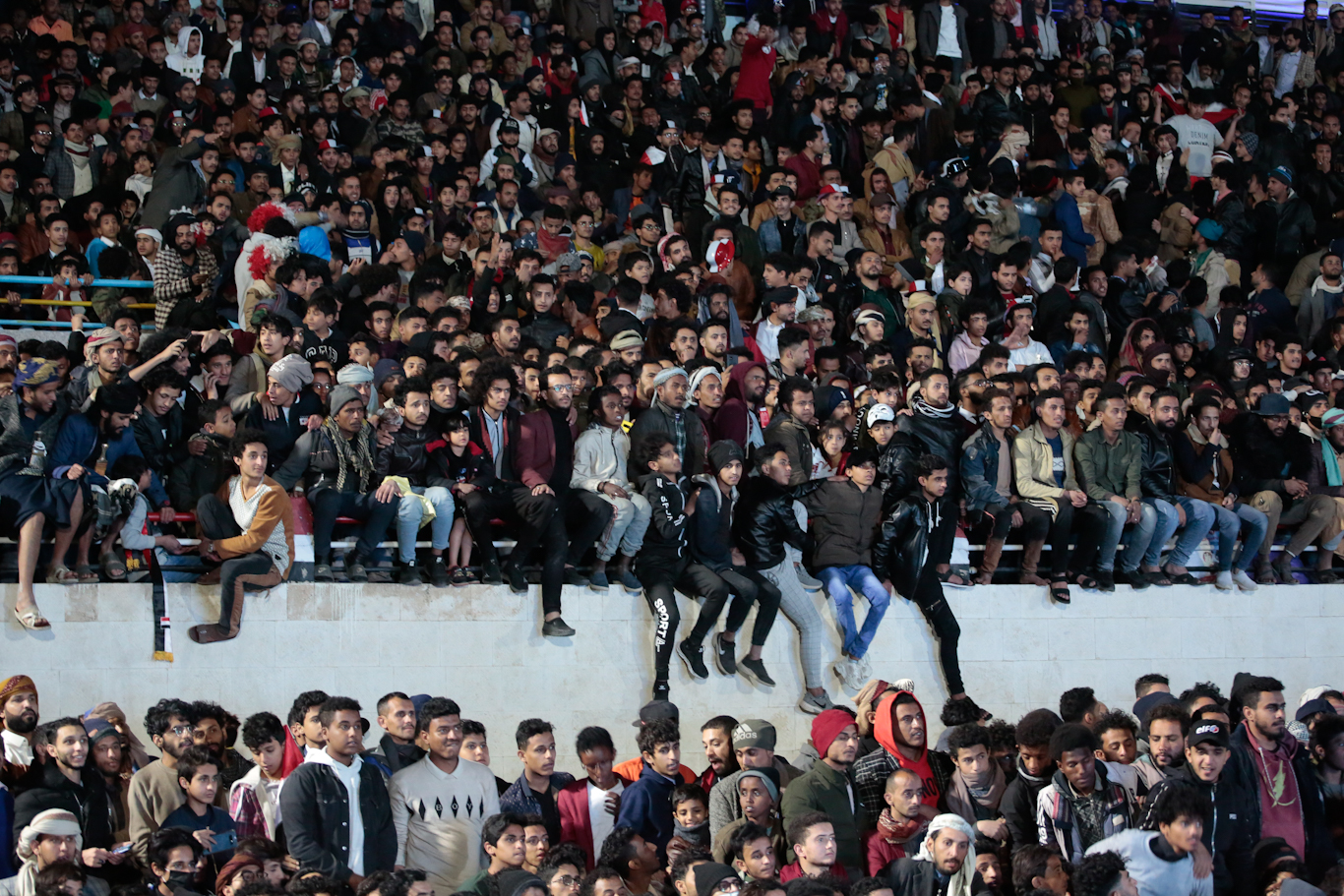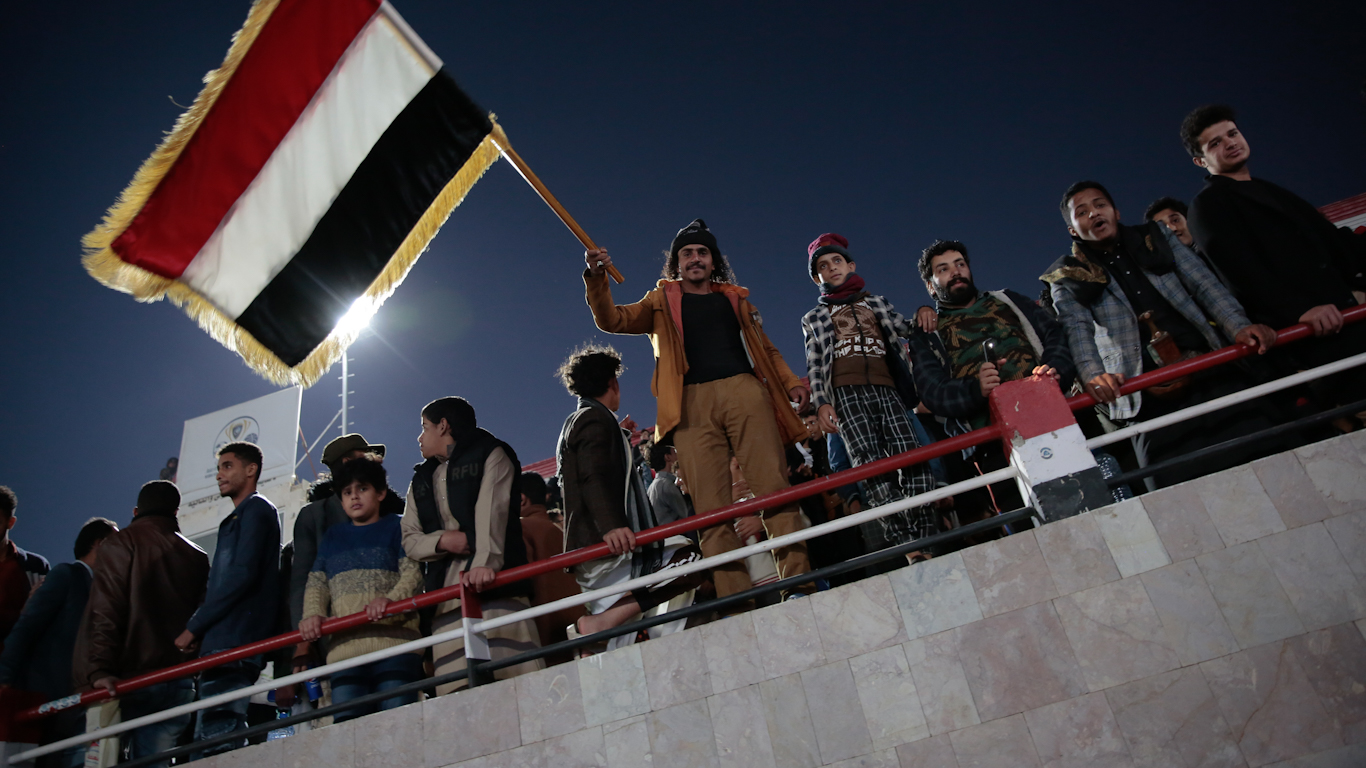SANA’A, YEMEN – As the Saudi war against Yemen enters 2022, Yemenis seem more determined than ever to hold victory ceremonies and forge ahead into another year of struggle against the Saudi onslaught – notwithstanding a new scorched-earth campaign launched by the oil-rich kingdom, dubbed Operation Happy Yemen Freedom. “As we did before, surely nothing will prevent us from achieving more victories during 2022, until the eventual liberation of all our homeland,” a fresh-faced teenager said during a sporting event at Althawra Sports City Stadium in Sana’a, where damaged stands could be seen, the result of a recent airstrike.
At the start of each new year, public celebrations take place around the world. In Yemen however, the start of 2022 was different. On Wednesday, the Yemeni U-15 football team returned home from Saudi Arabia. Despite the nearly seven years of war that has disabled nearly all aspects of life in their country, including sports, the young boys were crowned the West Asian Football Federation Champions on December 13. The achievement sparked widespread jubilation among Yemenis not seen in many years.
The victory had great symbolism, not only because the win in the regional football tournament was the first in the country’s history, but because a Yemeni team defeated its Saudi host 4-3 as the Saudi regime waged a brutal U.S.-backed war back home. “It was not just an athletic victory, but rather a clear symbolic victory against a regime that turned beautiful things in our life, like football, into hell,” Abdo Ali Al-Edresi, runner-up for the Asian Junior Championship in 2003 said of the win.
Upon their arrival home to their blockaded country, the Yemeni youth football team received a hero’s welcome for an entire week, cheered on by thousands who lined the streets in Aden, Lahj, IBB, Marib, and other cities. In Sana’a, thousands lined the streets on Wednesday as the national football team made its way through the crowds in an open-top truck before the formal homage that awaited them at the Althawra Sports City Stadium.
The celebration was held despite fears that it could be the target of a Saudi attack after Saudi Arabia threatened to bomb the stadium in the wake of the Championship loss, claiming the Houthis were using it to store weapons. The Houthis denied the claim and invited a team of international observers to inspect the stadium in order to verify it was free of weapons. “These boys have given us hope that more victories can be achieved in the future,” one fan said as he lay on his dorm bed at the University of Science and Technology in southern Sana’a. He had been wounded by a falling bullet from his own gun as he fired into the air during the celebrations.
A beautifully bloodless victory
The victory not only united Yemeni sports fans but also had very real political repercussions. In southern Yemen, where the war has left much of the population divided and quarreling amongst themselves amid the collapse of the economy and the lack of security and basic services, thousands took to the streets carrying the Yemeni flag and unleashing chants against Saudi Arabia.
Others, including local Saudi allies, held modest ceremonies and gave gifts to their own youth football leagues, hoping that the recent victory against Saudi Arabia would ignite new fervor among their own players.
In the north, where Yemeni forces are making substantial gains in pushing back Saudi troops, thousands rushed the streets. Fireworks and gunfire peppered the skies as the masses took to the streets in celebration. One hundred and twenty people were injured and five were killed by falling bullets just seconds after word of the victory spread and hundreds began firing into the air in celebration.
In the world of sports, raucous celebrations may be the norm following major international championships and home-team wins, but in war-afflicted Yemen – where millions struggle against the blockade, epidemics, starvation, and diseases – the victory not only has a clear moral and political symbolism, it also represents the culmination of a series of battlefield victories that Yemenis achieved in 2021 and sums up the mood of many who hope those victories will last in 2022.
“In our stadiums, bombs not only fall from the sky, but a ball rolls between players as fans wrought by devastation cheer,” Abdo Al-Edresi said. Al-Edresi was the star and captain of the Junior National Team that reached the 2003 World Cup Finals in Finland, the golden age of Yemeni football. He also is a survivor of a fierce battle that took place in the Al-Oz area in Hodeida, where his brother, a player in the Sana’a Shab Football Club, was killed. Like thousands of Yemeni athletes who play in partially-destroyed sports facilities, sometimes under bombardment, he never gives up. ”We are not just steadfast, but achieve victory whatever the reality may be. And we are going on,” he said.

The U-15 team’s victory was achieved despite the tragic state of sports in the country. The team had neither financial support nor opportunity to attend the expensive specialized training given to the Saudi team. The team comes from a country devastated by war, where sports infrastructure has been destroyed and athletes struggle to find work. Wadhah Radfani, U-15’s famed goalkeeper whom many credit for the team’s victory, was recently detained by Saudi-backed militants. At least 129 athletes have been killed and hundreds injured in Saudi airstrikes and on Yemen’s battlefields. More than 108 Yemeni sports facilities have been destroyed by Western weapons dropped from Saudi warplanes, according to a report issued by the Projects Sector of the Ministry of Youth and Sports. The ministry estimated the material loss at $1 billion, reporting that, among other targets, 7 major sports stadiums, 13 regional stadiums, 23 gyms, 9 youth hostels, 21 administrative headquarters, 6 sports headquarters, and 12 local stadiums have been destroyed in Saudi attacks.
Off the pitch, a violent frenzy
The repercussions of Yemen’s 2021 victories against Saudi Arabia, from the battlefield to the football field, may offer hope to Yemenis that a change may be on the horizon but have seemingly pumped Saudi Arabia into a violent frenzy. As the new year dawned, the oil-rich kingdom backed by Western governments launched a large-scale attack on Yemen, dropping thousands of tons of American and European-made weapons on dozens of populated areas. Civilian infrastructure, including sports facilities, was left in ruins following the onslaught, which killed scores of civilians, including many women and children. The Saudi-led Coalition’s framing of Operation Happy Yemen Freedom as not a war but “an effort to spur Yemen into development and prosperity,” has few Yemenis convinced.
In Sana’a, home to more than four million people packed into a densely-populated metropolitan area, the Saudis forge on with the scorched earth campaign they began in earnest in December, when they launched operation ”Golden Bow.” The onset of Golden Bow was, perhaps coincidentally, simultaneous with U-15’s victory in the final qualifiers of the West Asian Junior Championships. In Saada, the municipal water tank was targeted by Saudi-Coalition bombs on Tuesday, depriving 130,000 of the city’s residents of much-needed clean water.
The scenes of the destruction of family homes, vital infrastructure, factories, and water stations, which became famous across the world when Saudi Arabia launched its war in 2015, still plague Yemen in 2022. Heart-breaking scenes of the bodies of children being pulled from the rubble of their bombed-out homes and the bloodstained survivors on hospital beds are still prominent features on local nightly news reports.
Talking “Peace” US Arms Saudis for Latest Attack on Yemen’s People: Operation Golden Bow
Fabrication and retreat
Saudi Arabia says that its deadly air campaign “against military sites and stores of ballistic missiles” and drones must continue, claiming that the airstrikes are in accordance with international law.
In a press conference on Saturday, Turki al-Maliki, the official spokesperson of the Saudi-led Coalition, presented journalists a clip from a documentary about the U.S. invasion of Iraq claiming that it was footage of Houthi weapons and using it to justify airstrikes on Yemen’s strategic port of Hodeida.
Al-Maliki presented the clip as unequivocal evidence. “This is in a specific location, inside Hodeida port, which is composed of workshops of ballistic missiles, which are then transported out of the port,” he said, going on to claim that the location could not be revealed “at this time.” But the clip that al-Maliki showed journalists came from the documentary “Severe Clear,” about a U.S. Marine’s advance on Baghdad during the 2003 U.S. invasion. The footage that al-Maliki displayed as evidence of Houthi missiles can be seen in the documentary at the 01:09:25 mark.
This blunder is not without precedent. On December 26, al-Maliki presented another fabricated clip as a piece of evidence to prove that Hezbollah was active in Yemen. Critics quickly pounced on the Saudi regime, asserting that the footage was fabricated.
“Whatever the intensity of the bombing or the American and Western collusion with Riyadh, we will not back down,” the fresh-faced teenager at Althawra Sports City Stadium concluded. And indeed, both Riyadh and Abu Dhabi not only suffered massive losses on the ground in 2021 – despite the significant backing of the most powerful countries on earth – but the Yemeni Army led by Ansar Allah – along with tribes in al-Mahrah, Hadramout, Shabwa, and Aden – have steadily advanced militarily, politically, socially and economically despite what may be the single largest military operation ever undertaken on the Arabian Peninsula. Now, in 2022, neither Sana’a nor Sadaa and Hodeida have fallen to the Saudi Coalition. Yemenis are far from deterred from achieving victory and even celebrate despite the horrors to which they are subjected. Ansar Allah, or the “Houthis,” have not fallen back to the mountains, as resistance movements often do in asymmetric wars. Instead, the Yemeni forces led by Ansar Allah are still steadily gaining ground. On December 29, they captured the al-Yatama area in al-Jawf, which shares a border with Najran, Saudi Arabia. The victory removes a major barrier to Ansar Allah’s advancement into southern Saudi Arabia, perhaps a telling indication of what may come in 2022.
Feature photo | A Yemeni man holds his national flag as he and others watch the final of West Asian Junior Championships between Yemen and Saudi Arabia via a screen in Sanaa, Yemen, Dec. 13, 2021. Hani Mohammed | AP
Ahmed AbdulKareem is a Yemeni journalist based in Sana’a. He covers the war in Yemen for MintPress News as well as local Yemeni media.


